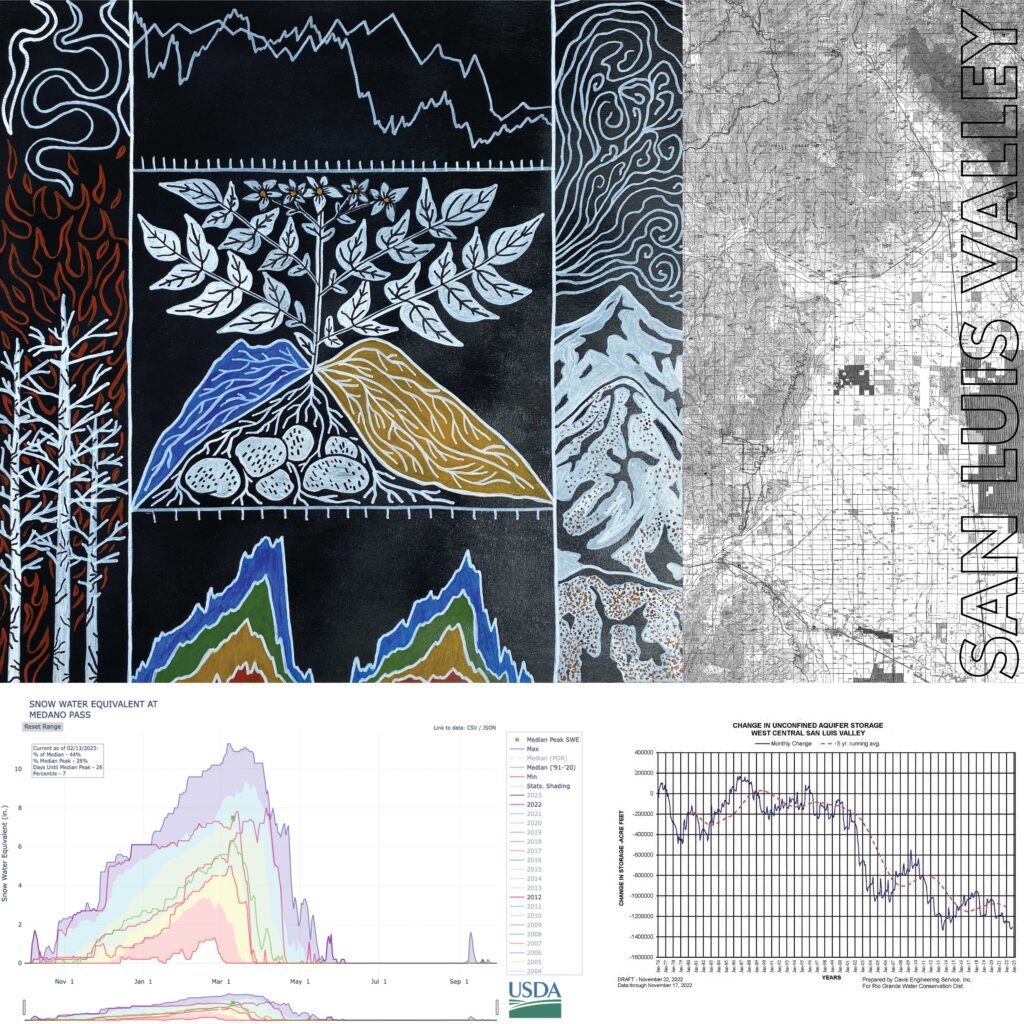
Making the Invisible Visible explores the ways communities of the San Luis Valley are experiencing and responding to issues tied to groundwater. The paintings represent an ongoing conversation between the artist, scientists, and the community on how to “make visible” the connections between changes in snowmelt and runoff, agriculture in the valley, and the aquifer below. The art illustrates the complexity and interconnectedness of multiple data sets and the community’s lived experience through varied artistic perspectives transcending the limits of what we are capable of seeing on the valley floor.
The data included, the locations portrayed, and the spatial/temporal variability among the paintings were all decided based on input from local community collaborators.
Art, Science, Place, and Community
Based on recommendations from community members, artist Jocelyn Catterson traveled to different locations in the San Luis Valley to incorporate visuals that represent groundwater problems in the community. The paintings depict these real locations from around the San Luis Valley, including the landscape, the local plants and the geology/hydrology underground. Some parts of the paintings are based on historic photos or maps of the valley provided by community members or found within historical archives. The geologic layers and the aquifer itself are represented as accurately as possible.
Data showing changes in the unconfined and confined aquifer levels, the amount of groundwater pumping in the valley, the snow water equivalent for the Upper Rio Grande Basin, and flow levels for the Rio Grande are all incorporated into the paintings. These data sets were chosen as the best scientific representation of groundwater issues in the San Luis Valley based on conversations with local scientists, nonprofits, and governmental agencies.
The data included, the locations portrayed, and the spatial/temporal variability among the paintings were all decided based on input from local community collaborators. These discussions included what visuals came to mind when thinking about issues tied to groundwater, places in the valley that best illustrate the issue, looking at more scientific depictions of the data/aquifer levels, and what each individual thought would be important to convey to the public about the issue.
What you can do to address this issue
Local Roots Guide to the San Luis Valley created by the San Luis Valley Local Food Coalition Support helps to support farms and ranches in the San Luis Valley that focus on sustainable agricultural practices and use less water. The guide helps direct community members on how to purchase food and products from valley businesses to support sustainable practices.
Environmental and Social Issues
Although the San Luis Valley is classified as a desert, the valley sits on a vast aquifer system. This groundwater not only supplies water to residents but creates ecologically important wetlands, artesian wells and crucial irrigation for agricultural lands. However, the aquifer storage levels have been dramatically decreasing over the last 30 years.
Various communities of the San Luis Valley have recognized the need to make changes tied to the use of groundwater in order to protect our aquifer and way of life. Over the last 20 years, people have worked together to decrease pumping and find more sustainable solutions to water usage and agriculture. However, other factors such as changes in snowpack and the timing of snowmelt have negatively affected the impact of these measures. The aquifer storage levels are continuing to drop despite decreases in human groundwater use.
Science Integrated into the Artwork
Jocelyn Catterson’s art addresses the natural resource issue of groundwater recharge, a process that occurs when rain or snow melt infiltrates below the surface into groundwater storage. Groundwater recharge may also refer to the amount of water added to groundwater storage in aquifers. In the arid and semi-arid regions of the United States, groundwater is a vital source of irrigation water for sustaining agriculture and supporting local economies. With changing rainfall and snowfall amounts, groundwater recharge has declined; however, irrigation demand remains high. As a result, there has been a decline in groundwater levels because annual recharge has not kept pace with withdrawals. The San Luis Valley has been particularly impacted by the decline in groundwater resources.
The artwork shown above is located in the Colorado State Capitol through October 16, 2023.





